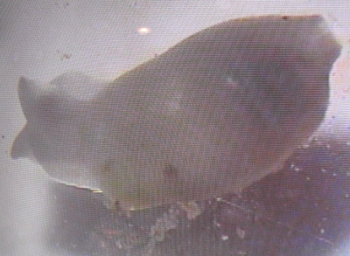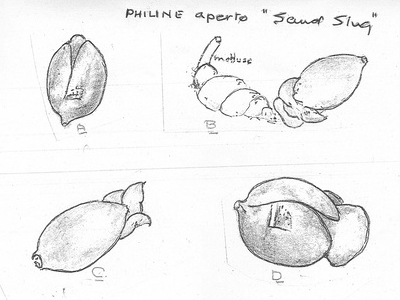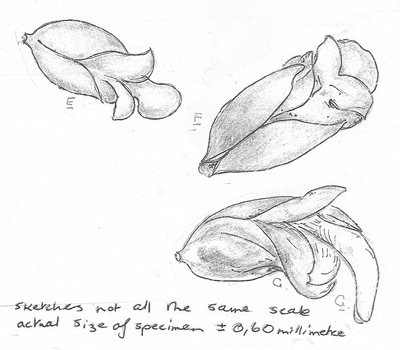Vovatella laguncula
Sowerby, 1894
Order: SACOGLOSSA
Superfamily: OXYNOOIDEA
Family: Volvatellidae
DISTRIBUTION
Apparently endemic to South Africa.
Volvatella laguncula is illustrated in Terry Gosliner's book on Sth African opisthobranchs. It was originally named on the basis of two empty shells, but Tom Thompson (1979) studied living animals and reported that it fed on the 'roots' of the green alga Caulerpa filiformis. Identifying species of Volvatella is difficult because we do not really know much about the geographic distribution and shell variability of any of the described species. On existing information, this species seems to be endemic to southern Africa.
The animal and shell are translucent white.
-
Thompson, T. E. (1979) Biology and relationships of the South African sacoglossan mollusc Volvatella laguncula. Journal of Zoology, London 189: 339-347, Figs 1,2a-d.
Rudman, W.B., 2008 (June 2) Vovatella laguncula Sowerby, 1894. [In] Sea Slug Forum. Australian Museum, Sydney. Available from http://www.seaslugforum.net/find/volvlagu
Related messages
Re: Volvatella from east of Cape Town
June 3, 2008
From: Evanne Rothwell

Concerning message #21593:
Hi Bill Rudman
Thank you for the information. The approx. size is about 2 mm. Attached is a photograph of the animal taken from the TV display as we do not have a picture capture facility on the microscope. It is magnified about 150 times and we have cropped the picture. It has since died.
The sketches were done by Lewis Jason, another volunteer at the aquarium who also discovered the animal.
One of the aquarists at the aquarium identified it as newly hatched Philine aperta. Any further comments?
Locality: False Bay Cape Town, Unknown, South Africa, Indian Ocean, May 2008, Unknown. Length: 2 mm. Photographer: Aquarium staff.
Evanne Rothwell
terry@marques.co.za
Rothwell, E., 2008 (Jun 3) Re: Volvatella from east of Cape Town. [Message in] Sea Slug Forum. Australian Museum, Sydney. Available from http://www.seaslugforum.net/find/21616Dear Evanne,
Thanks for the quick response. This is definitely a juvenile Volvatella. The photo confirms the accuracy of Lewis Jason's drawings, which show the cylindrical shape of the shell with its large exhalent siphon, and also show the stubby earlike tentacles on the head. Even very small juveniles of Philine have a more flattened shell which is capped posteriorly with the larval shell. There is no open siphon in Philine. Have a look at the pages on species of Philine to see the shape of the shell and the smooth stream-lined shape of the head end of the body. In Philine there are no head tentacles.
Best wishes,
Bill Rudman
Volvatella from east of Cape Town
June 2, 2008
From: Evanne Rothwell


Concerning message #12808:
I work as a volunteer at the Two Oceans Aquarium in Cape town, South Africa. I enclose some drawings of a Philine aperta (?) that was brought in. I would love some further information on it, especially on the purpose of the ?anal end of the animal. In fact, any information would be helpful. The following observations were made: Specimen found in the residues of a recovery dive in False bay. Almost invisible. It's colour is a transparent "Tupperware" with a darker area apparent through the skin. It appears to have an internal "flexible " shell. Shows active movement, flexing, extending, contracting and a colour change from the aforementioned colour to varieties of blue. The sketches A- G made as the animal moved around, ate.
Locality: Cape Town, ?, South Africa, False Bay (Indian Ocean), 27 May 2008, Retrieved from a dive - depth unknown. Length: 0.60 mm. Photographer: Illustrator - Jason Lewis.
Evanne Rothwell
terry@marques.co.za
Dear Evanne,
From the drawings I would say this is a species of Volvatella, and most probably Volvatella laguncula, which is illustrated in Terry Gosliner's book on Sth African opisthobranchs. It was originally named on the basis of two empty shells, but Tom Thompson (1979) studied living animals and reproted that it fed on the 'roots' of the green alga Caulerpa filiformis. Identifying species of Volvatella is a bit difficult ecause we do not really know much about the geographic distribution and shell varaibility of any of the described species, but on existing information, this species seems to be endemic to southern Africa.
The shell is in fact external, but as you describe it is flexible. It is a primitive sacoglossan slug, and like most of that group is a suctorial herbivore, sucking the cell contents from the 'roots' which anchor their food, Caulerpa filiformis, to the substrate. Have a look at other related species on the Forum by using the Species List.
One thing I find a bit puzzling is the size. Do you really mean 0.6 mm? That seems a bit small?
-
Thompson, T. E. (1979) Biology and relationships of the South African sacoglossan mollusc Volvatella laguncula. Journal of Zoology, London 189: 339-347, Figs 1,2a-d.
Best wishes,
Bill Rudman
